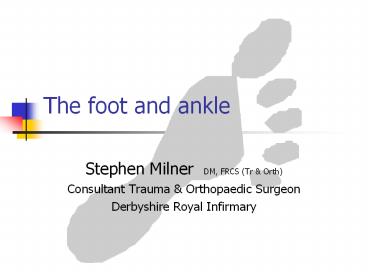The foot and ankle - PowerPoint PPT Presentation
1 / 37
Title:
The foot and ankle
Description:
The foot and ankle Stephen Milner DM, FRCS (Tr & Orth) Consultant Trauma & Orthopaedic Surgeon Derbyshire Royal Infirmary Man s foot is all his own – PowerPoint PPT presentation
Number of Views:444
Avg rating:3.0/5.0
Title: The foot and ankle
1
The foot and ankle
- Stephen Milner DM, FRCS (Tr Orth)
- Consultant Trauma Orthopaedic Surgeon
- Derbyshire Royal Infirmary
2
Mans foot is all his own
- It is unlike any other foot. It is the most
distinctly human part of the whole of his
anatomical make-up. It is a human specialisation
and, whether he be proud of it or not, it is his
hallmark and so long as Man has been Man and so
long as he remains Man, it is by his feet that he
will be known from all other members of the
animal kingdom. - Frederick Wood Jones (1879-1954).
- Professor of Human and Comparative Anatomy
- Royal College of Surgeons of England
3
Apes have four hands
4
(No Transcript)
5
Evolution of the foot
6
Bones joints of the foot
7
Ligaments Muscles
8
Functional parts of the foot
Forefoot
Midfoot
Hindfoot
9
Functions of the foot ankle
- Weight bearing
- Posture
- Locomotion
- Shock absorption
10
Terminology of movement
- Relative to the 3 orthogonal planes
- Sagittal plane
- Flexion - extension
- Coronal plane
- Abduction - adduction
- Transverse plane
- Internal external rotation
11
Foot and ankle movements
- No foot/ankle joint moves in one orthogonal plane
- Movements are biplanar or triplanar
- Such movements have their own names
- Dorsiflexion - plantarflexion
- Inversion eversion
12
The ankle
- Is formed by the tibia, fibula talus
- Is a hinge
- Takes over 5x body weight through a contact area
of only approx 4.5cm2 - Very rarely develops primary osteoarthritis
13
Find the axis of the ankle!
14
The talus is part of a cone
15
The ankle axis
16
Biplanar movements of ankle
- Dorsiflexion
- Extension, external rotation
- Plantarflexion
- Flexion, internal rotation
17
Why have an ankle joint?
- Lengthen stride
- Reduce up and down movement of the bodys centre
of gravity - Reduce force transmission through other joints
- Reduces energy expenditure
18
The subtalar joint
- Is formed by the talus and the calcaneum
- Consists of 3 separate articular facets
- Is important when walking on uneven ground
- Is a triplanar joint
- Is a mitred hinge
19
Mitred hinge concept
20
Subtalar movements
- Inversion
- Flexion Adduction Internal Rotation
- Eversion
- Extension Abduction External Rotation
21
The foot - arches
- Transverse
- Medial longitudinal
- Lateral longitudinal
22
Transverse arch
23
Longitudinal arches
- Medial is relatively immobile
- Lateral is lower but more mobile
24
The foot
- Is a tripod
- Is sometimes flexible
- Shock absorber
- Is sometimes rigid
- Lever
25
The foot as a tripod
Zone of stability
26
The foot as a shock absorber
- Heel strike
- Hindfoot moves into eversion
- Transverse tarsal joint unlocks
- Midfoot becomes flexible
27
The foot as a lever
- Toe off
- Hindfoot in inversion
- Transverse tarsal joint locked
- Midfoot rigid
28
Human gait
29
The action of muscles
- Force couples with opposing actions
- Tibialis posterior Peroneus brevis
- Tibialis anterior Peroneus longus
- Alter the rigidity of the foot through the gait
cycle - Position the foot in stance
- Maintaining a stable base
30
Examination of foot ankle
- Look
- Feel
- Move
31
Look
- Shape of foot
- Alignment of leg and foot in stance
- Gait
- Active movements
- Tiptoes, heels, inversion, eversion
- Skin
- Pressure points, callosities
- Shoes
32
Feel
- This is where you need to know your surface
anatomy! - Palpate individual structures for tenderness
- Assess swellings/synovitis
- Sensation/circulation
33
Move
- Each joint in turn
- Work from proximal to distal
- Compare with the other side
- Watch the patients face!
34
Special tests
- Ankle stability
- Ankle Impingement
- Gastrocnemius tightness
- Peroneal tendon subluxation
- Tibialis posterior function
- Coleman block test for hindfoot stiffness
- Mulder click test
- Lesser MTP joint stability
35
Common problems
- Injuries
- Fractures
- Ligament injuries
- Wear and tear
- Arthritis
- Tendonopathies
- Muscle imbalance
- Cavus feet
- Hallux valgus
- Lesser toe problems
36
Further information
- Interactive foot and ankle CDROM
- MacRaes Clinical Orthopaedic Examination
- Lots on the internet, one of the best is Jim
Barries Foot Ankle Hyperbook - http//www.blackburnfeet.org.uk/hyperbook/hist_exa
m.htm
37
The end!

